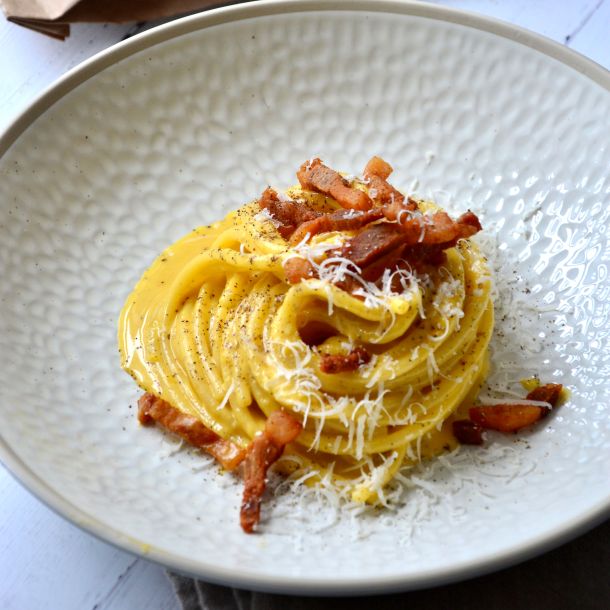The King of Italian Rice

Riso Carnaroli The King of Italian Rice
There are a few reasons that Carnaroli has earned its moniker, The King. This is a bit more technical than usual for us, but here's one reason...
Amylose is one of the two components of starch. The other is amylopectin. Basically, the higher the ratio of amylose to amylopectin, the more difficult it is for liquid to penetrate the starch in the rice. And the more difficult that is, the more slowly the rice releases its starch. And the more slowly that happens, the better the grain holds its shape and the more creamy the finished risotto.
Guess which variety of rice has the highest ratio? And now you can guess which quality Italian chefs favor most in their rice...
Whether we're making the classic Risotto Milanese (a simple risotto with saffron) or a more complicated Lobster Risotto (still quite simple), Carnaroli is our preferred rice. It's incredibly tasty and very forgiving (it has a longer window of perfectly-cooked perfection). Since it's very difficult to grow and the yield is comparatively low, it is often also known as the Beluga of rice...it is more expensive than it's brethren from the fields of Lucedio, but we're so consistently happy with the results, we think it's worth it.
But if you're not convinced, now is a great time to give it a test-drive. We brought in an extra-large order of the freshest rice from Principato Lucedio and are able to pass along a great price. Through the end of January, we're offering great deals on Lucedio's Carnaroli and Arborio.
500 gram Carnaroli Rice - normally $8.00, now for $6.50
2.2 pound Carnaroli Rice - normally $12.75, now $10.50
11 pound Carnaroli Rice - normally $56.00, now $45.00
Begin Shopping Now!
Riso Arborio
The Workhorse of Italian Rice
If Carnaroli is the King, Arborio is the hard-working brother; it's not in line for the throne, but it's a reliable workhorse.
The individual grains of Arborio are a little longer and slightly more flat than Carnaroli - which means that the rice will absorb slightly less liquid and the result will be less creamy. And as you can probably guess, the Amylose to Amylopectin ratio is lower. Why then, would you want this?
We love to use Arborio when we're making risotto for Arancini - basically, a ball of cooled risotto surrounding cheese or ragu, breaded and fried to crispy perfection. Arborio is also our preferred rice for rice salads, a dish that doesn't often appear in the US. It's boiled rice, (cooked like pasta) that is cooled slightly and tossed with vegetables and a vinaigrette. Our favorite version is studded with ham, blanched greens and topped with a poached egg. A perfect brunch dish...
500 gram Arborio Rice - normally $7.00, now for $6.00
An Oldie, but a Goodie...
From the annals of the MarketHallFoods.com newsletter, our recipe for 5-Step Risotto is one of the most viewed recipes online and in our Newsletter Archive.
5-Step Risotto
(serves 4 - 5)
- 3 tablespoons olive oil (you could use half butter, half oil if you prefer)
- 1 yellow onion, diced
- 1-2 cloves garlic, minced
- 500 grams of rice
- 1 cup of white wine
- 1 1/2 quarts good-quality chicken stock (boxed is OK, but use the best you can find)
- 3 tablespoons butter
- 1/2 - 3/4 cup grated Parmigiano Reggiano
- Saute the onion over medium-high heat in the olive oil until nicely softened, about 5 minutes. Add the garlic and cook for 2 minutes. Season with salt & pepper.
- Add your rice and stir, toasting the rice for 2-3 minutes.
- Add the wine and allow to reduce until the pan is almost dry.
- Add ladlefuls of HOT STOCK to the pot, one at a time, for about 15 - 18 minutes, stirring often. Each time the pan begins to dry, add more stock. The rice will slowly release the starch into the liquid, creating a thick sauce.This step is done when you taste the rice and determine that it's done - no sooner and no later!
- Off of the heat, add the butter and cheese, season with salt & pepper and adjust accordingly.
Now as we said, this is a recipe for a BASIC risotto. The options for embellishment are endless, but the variance in recipe is really insignificant.
Want a Butternut Squash risotto? Peel a squash and place the peels in your stock - it'll boost the flavor. Roast the butternut squash with olive oil, salt and pepper and add to the nearly finished risotto.
For Risi e Bisi, add some fresh or frozen peas to the end and serve it on the wet side - that's how it's done in Venice.
For a quick Risotto con il Pollo, add some cooked and shredded chicken thighs to your almost-finished risotto. Drizzle with a touch of aceto balsamico, as they do in Emilia Romagna.
Risotto con Gamberetti? Easy! Toss uncooked shrimp into your risotto about 5 minutes from done - that'll be enough to cook them. (Use fish stock or shellfish stock if you have it.) You "shouldn't" add cheese to this preparation, but it's your kitchen!


